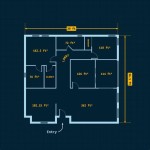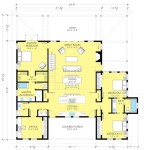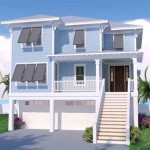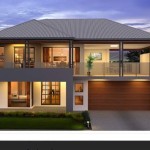40x80 Pole Barn House Plans: A Comprehensive Guide
Pole barn house plans, particularly those measuring 40x80 feet, are gaining popularity as a cost-effective and customizable housing solution. These structures, traditionally used for agricultural purposes, offer a unique blend of spaciousness, affordability, and design flexibility. Understanding the intricacies of 40x80 pole barn house plans is crucial for anyone considering this type of construction.
This comprehensive guide will delve into various aspects of 40x80 pole barn house plans, including their benefits, design considerations, construction process, cost factors, and potential challenges. By covering these key areas, this document aims to provide a thorough understanding of what is involved in creating a comfortable and functional living space within a 40x80 pole barn structure.
Benefits of Choosing a 40x80 Pole Barn House
Opting for a 40x80 pole barn house presents several advantages compared to conventional stick-built homes. These benefits range from cost savings and construction speed to design adaptability and energy efficiency. Examining these advantages is essential for determining if a pole barn house aligns with individual needs and preferences.
One of the most significant benefits is the lower construction cost. Pole barn construction typically requires less material and labor than traditional framing methods. The use of widely spaced posts allows for fewer load-bearing walls, reducing the need for extensive framing and foundation work. This can translate into substantial savings on material costs and labor expenses, making it an attractive option for budget-conscious individuals and families.
Another advantage is the speed of construction. Pole barn structures can be erected relatively quickly compared to stick-built homes. The simplified framing process and readily available materials contribute to a shorter construction timeline. This rapid construction allows homeowners to move into their new residence sooner, reducing the financial burden of interim housing arrangements.
Design flexibility is also a major selling point. The open-span design of pole barns allows for highly customizable interior layouts. With fewer load-bearing walls, homeowners have greater freedom to design their living spaces according to their specific needs and preferences. This flexibility is particularly appealing to those who desire unique architectural features or adaptable living arrangements.
Furthermore, pole barn houses can be designed for exceptional energy efficiency. With proper insulation and efficient heating and cooling systems, pole barn homes can maintain comfortable temperatures year-round while minimizing energy consumption. The large wall cavities inherent in pole barn construction provide ample space for insulation, contributing to improved thermal performance. This focus on energy efficiency can lead to significant long-term savings on utility bills.
Key Design Considerations for 40x80 Pole Barn House Plans
Designing a 40x80 pole barn house requires careful consideration of various factors, including layout, functionality, aesthetics, and compliance with local building codes. Addressing these considerations early in the design process is crucial for creating a comfortable, safe, and compliant living space.
The layout of the interior space is a critical design element. The 3200 square feet provided by a 40x80 structure offers ample room for various living areas, including bedrooms, bathrooms, kitchens, living rooms, and home offices. Careful planning is necessary to optimize the use of space and create a functional and comfortable living environment. Consider the flow of traffic between rooms and the placement of essential amenities to ensure usability and convenience.
Functionality should be a primary focus of the design process. Consider how the space will be used and tailor the layout to accommodate specific needs and lifestyles. For example, individuals who work from home may require a dedicated office space, while families with young children may prioritize play areas and storage solutions. Thoughtful consideration of functionality will enhance the overall livability of the pole barn house.
Aesthetics play a significant role in the overall appeal of the home. While pole barns are often associated with a rustic or utilitarian aesthetic, they can be designed with a wide range of architectural styles. Exterior finishes, such as siding, roofing, and windows, can be chosen to complement the surrounding environment and reflect personal tastes. Interior design elements, such as flooring, cabinetry, and lighting, can further enhance the aesthetic appeal of the living space.
Compliance with local building codes is paramount. Before beginning construction, it is essential to research and understand all applicable building codes and regulations. These codes typically address structural integrity, fire safety, electrical systems, plumbing, and other critical aspects of the building. Ensuring compliance with these codes is not only a legal requirement but also a crucial step in providing a safe and habitable living environment. Consult with local building officials to obtain the necessary permits and approvals before commencing construction.
Essential Steps in the 40x80 Pole Barn House Construction Process
The construction of a 40x80 pole barn house involves several distinct stages, each requiring careful planning and execution. Understanding these steps is essential for ensuring a successful and efficient construction process. From site preparation to interior finishing, each phase plays a crucial role in creating a durable and comfortable living space.
The first step is site preparation. This involves clearing the building site, grading the land, and ensuring proper drainage. A level and well-drained site is essential for the stability of the pole barn structure. Addressing any drainage issues early on will prevent water damage and prolong the lifespan of the building. Soil testing may be necessary to determine the load-bearing capacity of the ground and ensure adequate foundation support.
Next comes the post installation. This involves setting the posts into the ground, typically using concrete footings for added stability. The posts form the structural framework of the pole barn, supporting the roof and walls. The spacing and depth of the posts will depend on the design specifications and local building codes. Precise placement of the posts is crucial for ensuring the structural integrity of the building.
Following post installation is the framing and roofing. This involves attaching horizontal beams to the posts and constructing the roof structure. The framing provides support for the walls and the roof, while the roofing protects the interior from the elements. The choice of roofing materials will impact the overall look and performance of the building. Common roofing options include metal, asphalt shingles, and composite materials.
Once the framing and roofing are complete, the next step is wall construction. This involves attaching siding to the exterior of the posts and framing. The siding provides weather protection and enhances the aesthetic appeal of the building. Common siding options include metal, wood, vinyl, and fiber cement. Insulation should be installed within the wall cavities to improve energy efficiency and reduce heating and cooling costs.
Finally, the interior finishing includes installing electrical wiring, plumbing, insulation, drywall, flooring, and fixtures. This phase transforms the raw structure into a habitable living space. Careful attention to detail is essential during this stage to ensure a comfortable and functional living environment. Electrical wiring and plumbing should be installed by qualified professionals to ensure safety and code compliance.
Throughout the construction process, it is important to maintain communication with contractors and subcontractors. Regular site visits and progress meetings will help to ensure that the project stays on schedule and within budget. Addressing any issues or concerns promptly will prevent costly delays and ensure a satisfactory outcome.

Metal Building House Plans And Floor

Barndominium Style House Plan 3 Beds 2 5 Baths 2000 Sq Ft 430 333 Houseplans Com

Farmhouse Style House Plan 4 Beds 3 Baths 2390 Sq Ft 430 215 Houseplans Com

Ranch Style House Plan 4 Beds 3 5 Baths 3366 Sq Ft 430 190 Houseplans Com

Barndominium Style House Plan 2 Beds Baths 1260 Sq Ft 430 347 Houseplans Com

Barndominium Style House Plan 4 Beds 3 5 Baths 2703 Sq Ft 430 288 Houseplans Com

Farmhouse Style House Plan 3 Beds 2 5 Baths 2454 Sq Ft 430 229 Houseplans Com

Farmhouse Style House Plan 4 Beds 3 5 Baths 3086 Sq Ft 430 222 Houseplans Com

Farmhouse Style House Plan 2 Beds Baths 1448 Sq Ft 430 256 Houseplans Com

Cottage Style House Plan 3 Beds 2 Baths 1300 Sq Ft 430 40 Houseplans Com
Related Posts








